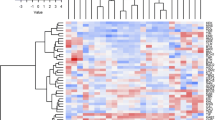Abstract
Thirty-five white maize (Zea mays L.) landraces were obtained by the Indian Agricultural Program of Ontario (IAPO) from native farmers in Ontario and New York State between 1986 and 1989. These landraces probably belong to the racial complex Northern Flints and Flours. The 35 landraces, one experimental population and one control hybrid were evaluated in field experiments at two sites in 1993 and 1994. Data were collected on 24 traits in order to characterize and classify the IAPO landraces. Most quantitative traits examined exhibited considerable variation among the IAPO landraces. Variation was also observed within many of the landraces for ear and cob colour, and for endosperm texture. Most ears had eight rows of kernels, but there was some variation for this among and within landraces. Based on seven traits from the two sites in 1994, the IAPO population was grouped into 10 clusters by centroid clustering analysis.
Similar content being viewed by others
References
Bendremer, J.C.M. & R.E. Dewar, 1994. The advent of prehistoric maize in New England. In: S. Johannessen & VC.A. Hastorf (Eds.), Corn and Corn Culture in the Prehistoric New World, pp. 369–398. Westview Press, Boulder, Colorado.
Brown, W.L. & E. Anderson, 1947. The northern flint corns. Ann MO Bot Gard 34: 1–29.
Burren, L.L., J.J. Mock & I.C. Anderson, 1974. Morphological and physiological traits in maize associated with tolerance to high plant density. Crop Sci 14: 426–429.
Cutler, H.C. & L.W. Blake, 1976. Plants from archaeological sites east of the Rockies. American Archaeology Report No.1 (microfiche). American Archaeology Division, University of Missouri, Columbia.
Doebley, J.F., M.M. Goodman & C.W. Stuber, 1986. Exceptional genetic divergence of Northern Flint corn. Amer J Bot 73: 64–69.
Falconer, D.S., 1981. Introduction to Quantitative Genetics, 2nd edn. Longman, New York.
Galinat, W.C. & J.H. Gunnerson, 1963. Spread of eight-rowed maize from the prehistoric southwest. Botanical Museum Leaflets. Harvard University 20: 117–160.
Goodman, M.M. & W.L. Brown, 1988. Races of corn. In: G.F. Sprague & J.W. Dudley (Eds.), Corn and Corn Improvement, pp. 33–79. ASA, Madison, Wisconsin.
Harrington, M.R., 1908. Some Seneca corn foods and their preparation. Reprinted from American Anthropologist. New Ser. Vol. 10(4), Lancaster.
Hébert, D., S. Fauré & I. Olivieri, 1994. Genetic, phenotypic, and environmental correlations in black medic, Medicago lupulina L. grown in three different environments. Theor Appl Genet 88: 604–613.
Johnson, L.A., 1991. Corn: Production, processing, and utilization. In: Handbook of Cereal Science and Technology, pp. 55–131. Marcel Dekker Inc., New York.
Mock, J.J. & R.B. Pearce, 1975. An ideotype of maize. Euphytica 24: 613–623.
Ontario Ministry of Agriculture, Food and Rural Affairs, 1995. Ontario Hybrid Corn Performance Trials. Ontario Corn Committee.
Parker, A.C., 1910. Iroquois uses of maize and other food plants. Education department bulletin, University of the State of New York, Bull. 144(No. 482).
Robertson, A., 1959. Sampling variance of the genetic correlation coefficient. Biom. 15: 469–485.
SAS Institute Inc. 1989. SAS/STAT User's Guide, Version 6, Fourth Edition, Volume 1, Cary, NC: SAS Institute Inc., 943 pp.
Wymer, D.A., 1994. The social context of early maize in the mid-Ohio Valley. In: S. Johannessen & C.A. Hastorf (Eds.), Corn and Corn Culture in the Prehistoric New World, pp. 411–426. Westview Press, Boulder, Colorado.
Author information
Authors and Affiliations
Rights and permissions
About this article
Cite this article
Azar, C., Mather, D.E. & Hamilton, R.I. Maize landraces of the St. Lawrence-Great Lakes region of North America. Euphytica 98, 141–148 (1997). https://doi.org/10.1023/A:1003035231969
Issue Date:
DOI: https://doi.org/10.1023/A:1003035231969




